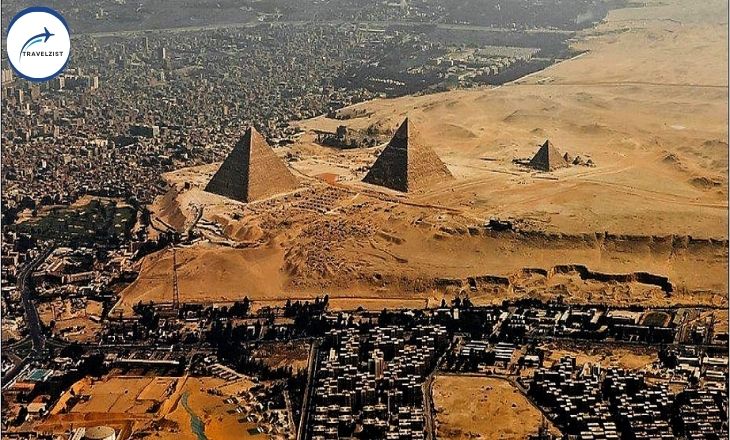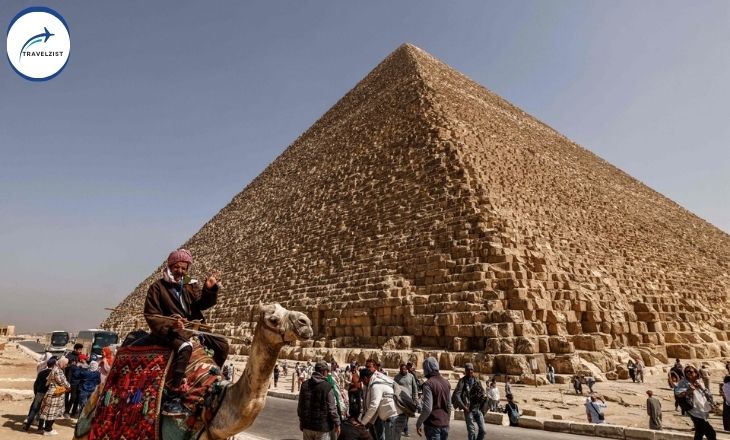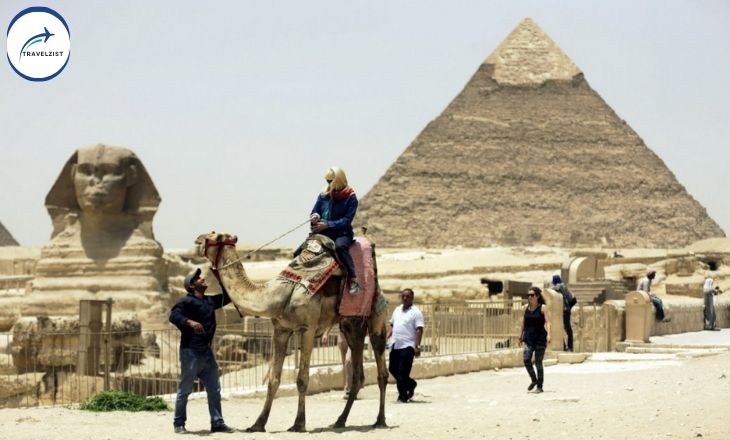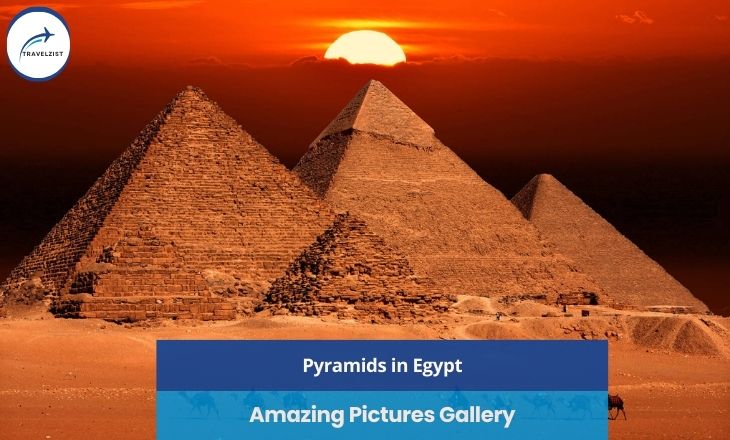Join us on a journey through time and space as we delve into the fascinating question: Where are the Pyramids in Egypt? The most famous Egyptian pyramids are those found at Giza, on the outskirts of Cairo. When one thinks of Egypt, the iconic image of the majestic pyramids immediately comes to mind.
These ancient wonders have captivated the world for centuries with their enigmatic allure and enduring mysteries. The Pyramids are not just scattered randomly across the desert sands but strategically positioned near each other, forming a sacred complex with secrets waiting to be unveiled.
Pyramids in Egypt-
Pyramids in Egypt stand as a testament to the engineering prowess and architectural ingenuity of the ancient civilizations that once thrived along the banks of the Nile. These massive structures, constructed thousands of years ago, continue to captivate visitors worldwide with their grandeur and mystery.

These monuments’ sheer size and precision have sparked endless debates and theories about how they were built, fueling a sense of awe and wonder that still lingers today.
One fascinating aspect of the pyramids is their alignment with astronomical phenomena, such as the alignment of certain pyramids with celestial bodies like Orion’s Belt. This suggests that ancient Egyptians possessed advanced knowledge of astronomy and were able to incorporate it into their architectural designs.
Recent discoveries have shed light on the complex burial rituals and beliefs surrounding the construction of these monumental tombs, offering new insights into how ancient Egyptian society viewed death and the afterlife.
By delving deeper into these enigmatic structures, we can uncover a rich tapestry of history, culture, and knowledge that intrigues us today.
Where are the Pyramids in Egypt and Their History
The Pyramids of Egypt are located primarily on the Giza Plateau, just outside of Cairo. These majestic structures have stood for thousands of years as a testament to ancient Egyptian engineering and culture. The most famous and largest pyramid is the Great Pyramid of Giza, built for Pharaoh Khufu around 2504 BC.

Over 100 pyramids have been discovered in Egypt, each with its own unique history and purpose. While most were constructed as tombs for pharaohs, some served other functions as well, such as the Step Pyramid at Saqqara, built by Djoser.

The construction of these incredible monuments involved immense manpower and resources, reflecting the power and wealth of ancient Egypt’s rulers. Despite centuries of erosion and plundering, these pyramids continue to awe visitors worldwide with their grandeur and mystery.
Quick Facts (Main Pyramid)
The main pyramid, erected in 2504 BC, is a striking testament to ancient Egyptian engineering prowess. Its astounding height of 150 meters and base length of the same measurement make it an impressive structure even by modern standards.

What truly boggles the mind is this magnificent monument’s incredible weight of 6 million tons. Comprising a staggering number of 2.3 million blocks meticulously crafted and placed together, the sheer scale and precision of this undertaking are nothing short of astonishing.
While we marvel at the main pyramid’s physical dimensions and weight-bearing capacity, let’s also delve into its symbolic significance within ancient Egyptian culture.
Beyond serving as monumental tombs for pharaohs, these pyramids were believed to represent a sacred connection between Earth and the sky, embodying cosmic harmony in their geometric perfection.
The meticulous alignment with celestial bodies highlights a profound spirituality and awareness of astronomical principles that guided the construction of these majestic structures.
As we gaze upon these architectural wonders standing resilient through millennia, we are reminded of human ingenuity and our eternal quest for understanding our place in the cosmos.
Best Day Tours To The Egypt Pyramids
Opting for a day tour the pyramids allows you to marvel at the Great Pyramid of Giza up close, which is an unforgettable experience. Standing in awe before this ancient wonder, with its intricate design and storied history, can be a profound moment that leaves you feeling connected to the past.
Exploring the surrounding complex and learning about the fascinating myths and theories behind these colossal structures adds layers of intrigue to your visit.
Venturing on a guided tour allows for insights from knowledgeable experts who can provide context and historical background that enriches your understanding of the pyramids beyond their impressive physical presence.
The chance to witness the precision engineering skills of ancient civilizations is educational and deeply inspiring as you ponder how such feats were achieved thousands of years ago.
Visiting these iconic landmarks offers a glimpse into humanity’s enduring quest for knowledge, leaving you with a sense of reverence for both our shared heritage and collective ingenuity.
The Great Pyramid of Giza Tour
Once you arrive at the Giza Plateau, prepare to be awestruck by the sheer magnitude and grandeur of the Great Pyramids. Opting for a guided tour can enhance your experience, providing insights into these ancient structures’ historical significance and architectural marvels.
Many tours also include visits to other notable sites in the area, such as the Sphinx and nearby temples, enriching your understanding of this remarkable archaeological wonder.
Exploring the Giza Pyramids allows you to immerse yourself in Egypt’s rich history and unravel the mysteries surrounding these iconic landmarks.
Witnessing these colossal structures up close is an unforgettable experience that offers a glimpse into ancient civilizations’ achievements and advancements in engineering and construction.
Capture breathtaking views, delve into intriguing legends, and marvel at the precision with which these monumental tombs were built thousands of years ago.
Giza Pyramids: What To Expect
Exploring the Great Pyramid of Giza is a mesmerizing experience transcending time and space. As you stand before this architectural marvel, prepare to awaken by its sheer size and majestic presence. The intricate details of the pyramid’s construction will leave you in awe, pondering the ingenuity of ancient civilizations.
Embark on a guided tour to unravel the mysteries hidden within these ancient structures. With each step, you’ll delve deeper into the history and significance of the pyramids, gaining a newfound appreciation for their cultural importance.
Witnessing the sun setting behind these towering monuments is a magical sight that will forever etch itself into your memory. As night falls over Giza, immerse yourself in the mystical ambiance surrounding the pyramids.
The quiet stillness of the desert at night creates an otherworldly atmosphere, enhancing your connection to this timeless wonder. Allow yourself to be transported back in time as you contemplate the enduring legacy of one of humanity’s greatest achievements: The Great Pyramid of Giza.
Chichen Itza vs the Great Pyramid of Giza
When comparing Chichen Itza and the Great Pyramid of Giza, it’s essential to acknowledge each site’s unique architectural styles and cultural significance. While both are ancient wonders, Chichen Itza stands out for its fusion of Mayan and Toltec influences, which is evident in the intricate carvings and astronomical alignments within the structures.
The Great Pyramid of Giza is a marvel of precision engineering, with its massive stone blocks perfectly aligned to cardinal points and serving as a testament to ancient Egyptian ingenuity.
A visit to the Great Pyramid of Giza offers a chance to delve into the mysteries surrounding its construction and purpose. The grandeur of this monumental structure can leave visitors in awe as they contemplate the labor-intensive techniques employed by ancient Egyptians to create such an enduring monument.
Exploring Chichen Itza allows for an immersive journey into Mesoamerican history, where elaborate temples and ball courts offer glimpses into a vibrant civilization that thrived centuries ago. Both sites are poignant reminders of humanity’s capacity for architectural innovation and cultural expression.
Camel Rides At The Egypt Pyramids
The thrilling adventure of camel rides at the Egypt Pyramids, don’t forget that negotiating the price and terms is part of the experience. The iconic Great Pyramid of Giza tour becomes even more magical when viewed from a majestic camel, allowing you to take the historical grandeur from a unique perspective.
The camel’s rhythmic swaying motion and gentle pace create a sense of timelessness, transporting you back to ancient Egypt’s glory days. The negotiation process can add excitement to your journey, offering insights into local customs and traditions.
Embrace this opportunity to interact with locals and better understand their way of life. By engaging in this economic exchange, you are not just haggling over prices but also connecting with the rich cultural tapestry surrounding one of the world’s wonders.
The Great Sphinx of Giza
The Great Sphinx of Giza is a symbol of the ancient world’s mystery and grandeur. With its enigmatic smile and majestic presence, the Sphinx is a silent guardian of the Great Pyramid complex. Theories about its true purpose and significance continue to intrigue historians and archaeologists alike.
As you stand before this mythical creature, imagine the stories it could tell if it could speak. Created over 4,500 years ago, the Sphinx has weathered centuries of history yet remains an enduring icon of Egyptian civilization.
Its colossal size and intricate design leave visitors in awe, evoking a sense of wonder at the ingenuity of those who built it. A tour of the Great Pyramid of Giza would be incomplete without pausing to marvel at the Great Sphinx.
As you gaze upon this ancient marvel, let your imagination roam free and ponder the mysteries that shroud its origins. The chance to witness such a majestic creation up close is an experience that will stay with you long after you leave its sandy surroundings.
Hotels Near The Egyptian Pyramids
The hotel near the Egyptian Pyramids is the Marvel Stone Hotel, offering a luxurious stay with stunning views of the ancient wonders. Imagine waking up to the majestic sight of the pyramids just outside your window, their timeless beauty mesmerizing you at every glance.
With modern amenities and exceptional service, this hotel provides a unique opportunity to immerse yourself in Egypt’s rich history and culture.
As you step out of the hotel doors, you are instantly transported back in time to an era of pharaohs and gods, where pyramids stood as symbols of power and eternity.
The close proximity to these architectural marvels allows for convenient exploration at any time of day, whether you wish to witness the sunrise over the desert sands or marvel at the pyramids illuminated under a starry night sky.
Staying at a hotel so close to such iconic landmarks offers comfort and convenience and a profound connection to one of humanity’s greatest achievements.
Binding
We found an answer: Where are the Pyramids in Egypt? How do we visit there and much more? The Pyramids in Egypt are located primarily on the Giza Plateau near Cairo.
These ancient structures have captivated visitors for centuries with their grandeur and mysterious origins. The most famous pyramids, including the Great Pyramid of Giza, serve as a reminder of the remarkable architectural and engineering feats achieved by the ancient Egyptians.
Exploring these iconic landmarks offers a glimpse into this fascinating civilization’s rich history and culture. To truly appreciate the magnificence of the Pyramids in Egypt, plan a visit to witness these awe-inspiring monuments firsthand.
FAQs
Are the Pyramids 10,000 Years Old?
Historical records and evidence from archaeological excavations support this timeline, indicating that the pyramids are approximately 4,500 years old.
Claims suggesting that the pyramids are 10,000 years old often lack substantial evidence and do not align with the established chronology of ancient Egyptian history.
Did the Egyptians live 5000 Years ago?
Yes, the Egyptians did live 5,000 years ago. The ancient Egyptian civilization dates back to around 3100 BCE with the unification of Upper and Lower Egypt by King Menes. This marked the beginning of the Old Kingdom period, which lasted until around 2181 BCE.
- Introduction to Our Blog: A Fresh Perspective - 21 September 2024
- Welcome to Our New Blog Site: Your Source for Unique and Useful Content - 18 September 2024
- Tukad Cepung Waterfall In Bali : Visitor Guide (2024) - 24 May 2024

